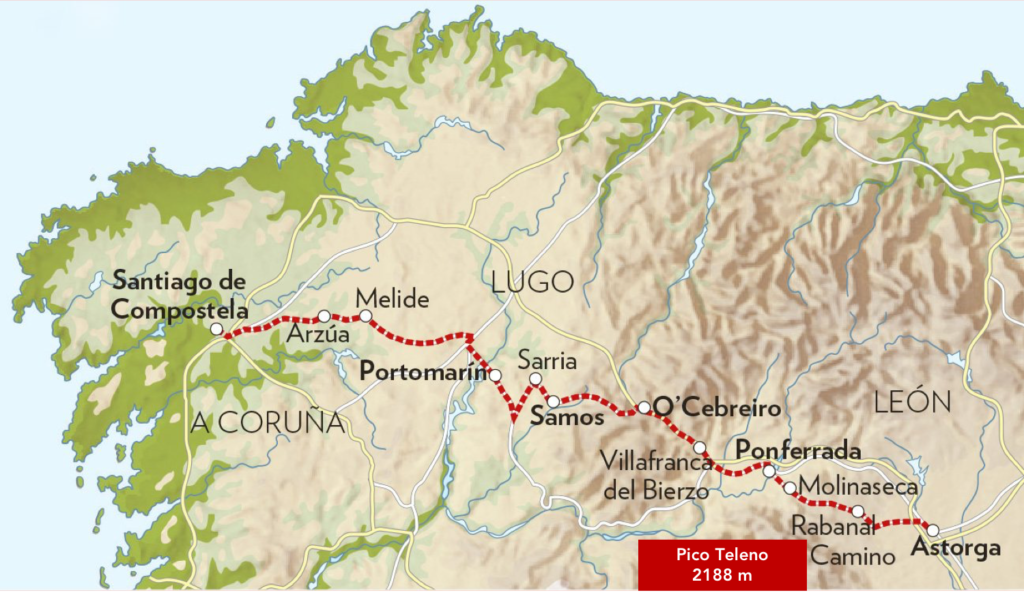It is in this part of the site that the main route that pilgrims follow from León to Santiago is described. The steps are therefore described in chronological order.
Have a good trip.
Camino francés from León to Santiago
There is no need to redo an extensive introduction to the Camino Francés here. You can refer to the general home page, if there is additional information that you would like to know. We did this second part of the Camino in autumn, in good weather, and without the heat wave. What happiness, after having suffered the rain and the cold, in the spring, in the first part of the route to León.
Beyond León, the Camino still drags a little in the hints of Meseta. It is still, for two days, the “Ruta Pelagración“, these tracks that run along the asphalt roads, in the middle of the fields, where corn now supplants wheat and barley. This indigent spectacle will last until Hospital de Órbigo and its incredible bridge. From here, the Montes de León loom in front of you and the route becomes hillier and more beautiful to reach Astorga and its prestigious monuments. The route then runs into the mountains, passing through formerly abandoned villages which have been restored to their former glory thanks to the Camino. The magnificent route passes the Irago Pass, the highest point of the Spanish Camino, and descends into the rocks in the Bierzo valley. The villages here, Rabanal del Camino, El Acebo, Molinaseca, have an unspeakable charm. Crossing the Bierzo Valley will probably not spark your enthusiasm, but you will be comforted when you arrive at Villafrsanca del Bierzo and its rich Jacobean heritage. It will then be a long climb again on the Montes de León, without passion in its slow approach to the mountain, to arrive at O Cebreiro, the other mythical village of the Camino, like Roncesvalles. Here the route leaves Castilla y León for Galicia.
Beyond O Cebreiro, it’s an exhilarating descent over the foothills of the mountain to Triacastella and then to Sarria, the hub of Galicia. It is here that the considerable hordes of pilgrims who make their way to Santiago form. From Sarria to Santiago, you will most often walk through beautiful forests, where eucalyptus trees taunt the pines, in a rich vernacular heritage. What about Santiago? When you see the compact crowd on Cathedral Square, you will no doubt understand why the Camino arouses so much passion. If you feel up to it, you may go to the end of the continent, to Fisterra. But, few pilgrims go there.

A little back on the statistics
What do the statistics of the office of Compostela tell us for 2011? Of the pilgrims who arrive in Santiago, only 55% of them have followed the Camino francés. The others followed mainly the Portuguese tracks, and even less the two other tracks in northern Spain, which are the Camino del Norte and the Camino Primitivo.
| Tracks | Number of pilgrims |
| Camino francés | 190’000 (54.7%) |
| Camino portugués | 950’000 (27%) |
| Camino del Norte | 19’000 (5.5%) |
| Camino Primitivo | 15.700 (4.5%) |
| Autres | 9.3% |
Let us now take the places of departure of the people who follow the Camino francés.
| Place of departure | Number of pilgrims |
| St Jean-Pied-de-Port/Roncevaux | 36’000/190’000, soit 19% |
| León | 10’5000/190’000, soit 6% |
| Astorga | 11’000/190’000, soit 6% |
| Sarria | 96’000/190’000, soit 51% |
| Aurtres villes | 14% |
The table shows that only a minority of pilgrims arriving in Santiago have done the entire Camino Frances (19%). The bulk of the battalion of pilgrims of the Camino Francés, more than half, leave from Sarria, shortly before Santiago. Just a few steps to get the certificate in Santiago. With these figures, we can try to understand why there are so many pilgrims on the route beyond Sarria. Before Sarria, there are therefore about 270 pilgrims per day, on average in the year. But, there are obviously months that are definitely busier than others. Beyond Sarria, the figure thus increases to 540 pilgrims per day. But, as we have said elsewhere, these statistics are completely false, since they only consider pilgrims who pass through the Camino office in Santiago with their “credencial”. Having made our personal statistics of pilgrims who have a “credential”, we can tell you that more than half of the pilgrims are concerned with this document as with their own shirt. From then on, you can comfortably double these figures, and have from Sarria 1,000 more pilgrims per day, or even more. You will then understand better why there is sometimes a continuous line on the course.
Therefore, this guide gives additional information that we dare to hope useful for any pilgrim, who would like to have additional information to prepare or make the trip. Simply refer to the menu at the Route of your choice
 |
To continue the route beyond León |
